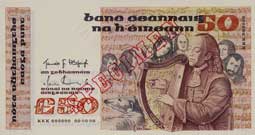
![]()
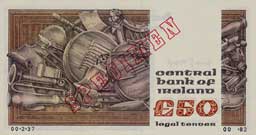
The Central Bank of Ireland Archive, opened to public access in 2017, has provided new source material on the design and production of the Irish Series B banknotes. Where content in this article draws on information from the archive it is referenced as CBIAR in the text.
The theme of the O’Carolan £50 note is the musical heritage of Ireland from the 17th to 19th centuries. The overall theme of the new Series B banknotes is Irish Writers, Philosophers and Artists. The banknotes were also designed with a deliberate Irish 'Celtic' feel to them.
Ireland's Series B banknotes are sometimes referred to as the 'Celtic Design Series'. The Irish 50 pounds denomination with portrait of Turlough O’Carolan [2.] playing an Irish Harp and its theme centered around music in Ireland blends in well with the overall Celtic feel to the design.

![]()
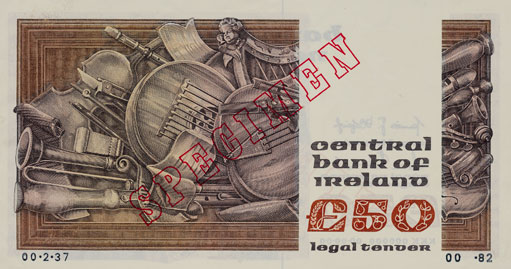
The O'Carolan 50 pound note was also the only banknote of the series to enter circulation on its date of issue, 1 November 1982. With the subsequent cancellation of the development of the Series B £100, the £50 note was the final denomination of the series to enter circulation.
Michael Biggs of the Servicon team had designed in 1953 a modern typeface based on Unical. This typeface was used on the Turlough O’Carolan 50 pound note as well as on all the other Series B banknotes.
The Series B £50 Pound note was the final denomination of the series to be issued. Although the £50 Turlough O’Carolan and £100 Grace O'Malley had been developed together after work on the £20 was completed, the £100 note was cancelled some years after the £50 was issued in 1982 [CBIAR].
On the face, is the text in Irish 'Banc Ceannais na h-Éireann' (Central Bank of Ireland) 'Nóta dlíthairgthe caoga punt' (Legal tender note fifty pounds). Below the signature are the titles of the signatories in Irish: 'an gobharnóir' (governor) and 'rúnaí na roinne airgeadais' (secretary of the department of finance).
On the reverse is the text in English, 'Central Bank of Ireland', '£50', 'Legal Tender Note'.
![]()
![]()
![]()
A close up of the design work on the main denomination in numerals of the Series B Irish 50 pound note
On the right of the Series B Irish 50 pounds is a large portrait of Turlough O’Carolan (1670-1738), who was a famous Irish harpist and composer.
The symbol in the centre of the note is the harp and the Irish wolfhound behind it. In the background are details of a painting by James Timbrell (1807-1850)[3.] of a group of people listening to music. This is overlaid on excerpts of music from Carolan and from John Field (1782-1837) [4.], and an excerpt from the collection of Edward Bunting (1773-1843) [5.].

The Symbol, an Irish harp, in the centre of the Turlough O’Carolan Fifty Pound note
The reverse design is based on a wood carving on the organ loft in St. Michan's church [6.] in Dublin, where Handel [7.] composed the Messiah [8.], which was first performed at the Musick Hall in Dublin on April 13, 1742 [9.].
Although the biggest banknote of the Series B, The Turlough O’Carolan 50 Pound note was still considerably smaller than the Series A 'Lady Lavery' Irish 50 Pound note which it replaced. The old design Series A 'Lavery' banknotes had been in circulation since 1928.
The dimensions of Irish bank notes tended to vary by a millimetre or so. The dimensions below are from measurements of actual notes.
Series A, Lady Lavery 50 Pound Note, 203 x 114 mm.
Series B, Turlough O’Carolan 50 Pound Note, 180 x 94 mm.
Below are illustrated the final date of Series A Irish 50 pound notes, 4 April 1977; and the first date of Series B Irish 50 notes, 1 November 1982.
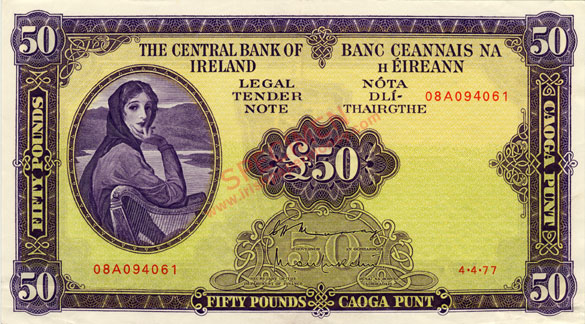
![]()

The 'Irish Punt series' is a commonly used term for the Series B banknotes, more often abroad than in Ireland, likely due to their being printed only in Irish on the face side.
The Turlough O’Carolan '50 Punt' was by far the least common of the denominations, and was seldom seen in general circulation.
There is no record of 50 Punt ever having been issued through ATMs
However, because there are only two dates of issue, examples of this Irish 50 pound note are easy to obtain in circulated condition, and not difficult to obtain up to AU grade. Examples of the notes were retained by dealers and hoarders as well as collectors. At least one block of a thousand 1982 Turlough O’Carolan 50 pound notes is known to have been kept, though these notes are mostly AU grade.
True UNC grade examples (with four sharp corners and no handling, grade 67 with quality mark, or better) of either date are difficult to obtain.
The face and reverse of the Carolan 50 pound note is primarily brown, with a yellow underprint.
Metallic Thread: A metallic security thread is embedded in the paper of the Carolan 50 pound note, slightly to the right of center when the note is viewed from the face side. The metal thread was a standard security feature used in banknote manufacture of the time, and had been introduced first to Irish currency notes in the 1970s.
Certain areas of the face the Series B £50 note fluoresce under UV light.
The Carloan 50 pound note had the most advanced UV activity of the Series B banknotes.
The denomination in numerals on both the face and reverse fluoresce under UV light. Additionally, the date and serial numbers fluoresce. And, in common with the other denominations of Series B banknotes, there is a UV active strip which runs down the middle of the face and reverse of each Series B 50 pound note.
The O’Carolan 50 Pound note was the final denomination of Series B to enter circulation.
The O’Carolan note circulated for 14 years until it was replaced by the Series C Irish 50 note with portrait of Douglas Hyde on 3 November 1995.
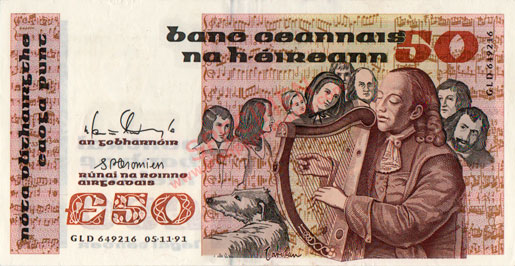
![]()

Type 18 Irish 50 pound note: Signatures: Tomás F. Ó Cofaigh, Maurice Doyle. 1 Date, 01.11.82.
Type 19 Irish 50 pound note: Signatures: Maurice Doyle, S. P. Cromien. 1 Date, 05.11.91.

![]()

The two signature varieties of the Series B Irish 50 Pound Turlough O’Carolan note
There were only two dates of issue for the Irish Series B 50 note, 01.11.82, and 05.11.91. Neither date was printed with a complete prefix range. 01.11.81 uses prefixes CFK-JFK (8 million notes), and 05.11.91 uses prefixes DLD-HLD (5 million notes).
The Turlough O’Carolan fifty pound notes are common, and easy to obtain. The notes fetch a significant premium in grades EF or better. The first date, 01.11.82 with Ó'Cofaigh, Doyle signatures is common in AU grade. The second date, 05.11.91 with Doyle, Cromien signatures, is much scarcer in grades of AU and better. An image of both dates of issue is on the Series B 50 Pound Note Dates page.
Both dates of the Carolan 50 note were printed as replacement notes with KKK prefix.
Irish 50 pound replacement notes are rarely offered for either date. At least two examples of replacement notes dated 01.11.82 are known in UNC grade, having been obtained by collectors directly from a block at the Central Bank of Ireland. The two notes are close in number, but non-sequential.
Three further examples are known in GVF grade, with a few notes seen in grades lower than VF.
There are no examples known in UNC grade of Irish 50 pound KKK replacement notes dated 05.11.91. Three examples have been recorded in AU grade, and less than ten examples in EF grade.
A few examples of KKK replacement Irish 50 pound notes have been recorded in grades lower than VF.
References [Last retrieved 04.08.24]
1. Central Bank of Ireland Archives, Dublin. Referred to as CBIAR in the text. [Accessed 24 May 2018].
2. Turlough O'Carolan. <https://www.dib.ie/biography/carolan-turlough-o-cearbhallain-toirdhealbhach-a1492>
3. James Timbrell. <https://www.libraryireland.com/irishartists/james-christopher-timbrell.php>
4. John Field. <https://www.dib.ie/biography/field-john-a3074>
5. Edward Bunting <https://www.dib.ie/biography/bunting-edward-a1117>
6. St. Michan's church, Dublin. <https://www.archiseek.com/2010/1686-st-michans-church-of-ireland-church-street-dublin>
7. Handel, music composer. <https://www.britannica.com/biography/George-Frideric-Handel>
8. Handel's Messiah. <https://www.youtube.com/watch?v=XiBHbadRVBU>
9. The Musick Hall, Dublin. https://www.smithsonianmag.com/arts-culture/the-glorious-history-of-handels-messiah-148168540/
Background Reading
1. Malcolm Knight, Stardust Windowed Thread <https://currencyaffairs.org/hall-of-fame/malcolm-knight/>
2. Nakamura, C. (2010). The Security Printing Practices of Banknotes. <https://core.ac.uk/download/pdf/19136612.pdf>
1 Pound Ploughman
5 Pounds Ploughman
10 Pounds Ploughman
20 Pounds Ploughman
50 Pounds Ploughman
100 Pounds Ploughman
Irish Ten Shilling Notes
1 Pound Note Lady Lavery
5 Pounds Lady Lavery
10 Pounds Lady Lavery
20 Pounds Lady Lavery
50 Pounds Lady Lavery
100 Pounds Lady Lavery
1 Pound Note, Queen Medb
5 Pound Note, John Scotus Eriugena
10 Pound Note, Jonathan Swift
20 Pound Note, W. B. Yeats
50 Pound Note, Turlough O'Carolan
100 Pound Note, Grace O'Malley
5 Pound Note, Sister Catherine McAuley
10 Pound Note, James Joyce
20 Pound Note, Daniel O'Connell
50 Pound Note, Douglas Hyde
100 Pound Note, Charles Stewart Parnell
Northen Ireland Polymer notes
Bank of Ireland Polymer Notes
Danske Bank Polymer Notes
Ulster Bank Polymer Notes
Special Sections and Articles
The Transition of Irish Currency, Irish banknotes 1918–1928
The Partition of Irish Currency, Irish banknotes 1928–1930
Banknote Design Evolution 1824 to 1916
Irish Three Pound Notes
Contemporary Forgeries of Early Irish Banknotes, ca1800-1930
Limerick Soviet Notes
Irish World War 2 Banknote Issues
Low Number Irish Banknotes
Irish Joint Stock Banks of Note Issue from 1783
Irish Legal Tender Note Specimens
Ploughman Scan Survey (PSS)
![]() Stable version. Revision to follow with addition of design details. Last update 20.08.24.
Stable version. Revision to follow with addition of design details. Last update 20.08.24.